#hystricomorph
Text

Guinea pig eating lettuce
By: Mervin F. Roberts
From: Guinea Pigs for Beginners
1972
#guinea pig#hystricomorph#rodent#mammal#1972#1970s#Mervin F. Roberts#Guinea Pigs for Beginners (1972)
240 notes
·
View notes
Text
I thought my favorite Metazooa category was "it is a group of animals whose anus develops before their mouth" but then it gave me "any rodent with a hystricomorphous zygomasseteric system". Oh wow, yeah, a hystricomorphous zygomasseteric system. Really narrows it down chief
51 notes
·
View notes
Text
Mammals of Lemuria
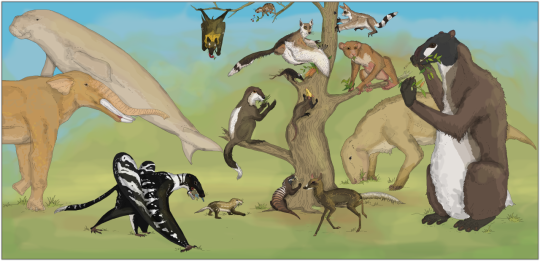
A sample of Lemuria’s native mammals: the Babana (lemurian elephant), the Alanja (freshwater dugong), two dryolestoids (the bark chewing Wemtole and the ungulate-like Tikabul), four gondwanatheres (the small Enia on the ground, the massive browsing Undaga, the perching Adala and a berry-eating Icze), two tenrecs (both on the tree, the yellow-headed Calikek and the white eared Tuco), the flying fox Walina, the volaticothere Walamul on the ground and of course four primates (the massive Caodaga, the sloth-like Caoze, the feathered flying Wagal and the membrane gliding Watole).
Like most landmasses, Lemuria busts a great mammalian fauna. But while placentals remain dominant here, various other “archaic” groups are also present: the gondwanatheres, the dryolestoids and the flying volaticotheres.
When Maldivia and Marama were seperate, both boasted different mammalian faunas. On the western landmass, the common gondwanan groups dryolestoids and gondwanatheres thrived, alongside the recently arrived lemurs and tenrecs. On the eastern landmass, on the other hand, a more mosaic fauna evolved: hystricomorph rodents, adapids, lorises and lagomorphs arrived by rafting from Asia, meeting with the already present volaticotheres and monotremes. When the landmasses collided hystricomorph rodents and lagomorphs were largely replaced by gondwanatheres (with the exception of the Uaemotol) while dryolestloids declined due to climatic changes, leaving only two clades. At the same time, hippos and elephants swam from Asia (and the freshwater dugong became isolated in the Great Lakes), putting pressure on the largest native herbivores, while rafting rats have yet to make a dent in the island’s fauna. Bats have been present throughout all this.
With extensive human occupation, one would think most of Lemuria’s megafauna would have become extinct. This is not the case; only 30% of all mammal species became extinct due to pre-modern human activity. This parallels long periods of longevity between megafauna and humans not only in the surrounding continents of Africa and Asia but even in islands (diprotodonts at least managed to co-exist with Aboriginal Australians for over 30 thounsand years and both Caribbeans and Caribbean megafauna lasted together for at least 3 thousand years). This is in part thanks to the largely non-intrusive native agriculture, and in part thanks to cultural preservation of some species like the Babana and Alanja.
Still, in modern times deflorestation, poaching and other hazards may put this co-existence to an end….
Elephants of Lemuria
The Freshwater Dugong
Tenrecs of Lemuria
Primates of Lemuria
Glires of Lemuria
Gondwanatheres of Lemuria
Flying mammals of Lemuria
Monotremes of Lemuria
Dryolestoids of Lemuria
13 notes
·
View notes
Text
Grass cutter.

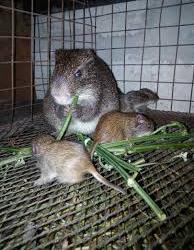
The Grasscutter: A Livestock of Tomorrow.
The grasscutter (Thryonomys swinderianus), variously known as the marsh cane-rat, ground hog and in francophone West Africa,
the aulacode or incorrectly, the agouti is a rodent but not a rat proper, since it belongs to the Hystricomorpha (porcupine family).
Life of the Grasscutter:
Grasscutters live above ground and are considered to be nocturnal. However, during the rainy season when sufficient security, shade and moisture are available, they are sometimes active during the day. After a certain period of acclimatization to their enclosure, grasscutters under studies have also started to feed by day.
Grasscutters are harmless and their response to danger is generally to flee. They often live in groups of 3 to 12 individuals: 1 male and 2 to 3 females with their offspring. The search for food and mating by the grasscutter is generally done between 5 pm and midnight and again at first light. The rest of the period is spent in rest, chiefly grooming and searching for a nest.
Globally, wildlife has great potentials for meat production and serves as an important source of the highly desired animal protein.
However, with ever increasing human population and obvious protein shortage in Africa, there is the need for an exploration of other means to provide readily acceptable meat on short term basis.
Wildlife domestication has been recognized as a way of achieving this objective. A few number of small mammal and crop farmers, trade or breed wild rodents
Among the wild rodents, the grasscutter, or cane rat or cane cutter is the most preferred. Grasscutter is a wild hystricomorphic rodent widely distributed in the African sub-region and exploited in most areas as a source of animal protein. Being the most preferred and most expensive meat in West Africa including Nigeria, Togo, Benin, Ghana and Cote d’ voire, it contributes to both local and export earning of most West African Countries.
egfg 👨🏿🌾
10 notes
·
View notes
Text
You're not a REAL michigander if you dont know the common names of the following: Sciurus niger Sciurus carolinensis Tamiasciurus hudsonicus Tamia striatus Glaucomys volans Spermophilus tridecumlineaus Marmota monax Castor canadensis Zapus hudsonicus (which is hystricomorphous) Rattus norvegicus Mus muscilus Ondatra zibethicus Microtus ochragaster Peromyscus maniculatus
1 note
·
View note
Text
Porcupine
The porcupine (

The porcupine (Hystricomorph Hystricidae), is an amazing creature that originated from South Asia, Europe, and most parts of Africa. Porcupines have needles on their body that protects them from predators that may harm them. This is how they are very good at surviving. Porcupines live in woodland areas because they like to climb trees and live in them. For porcupines to be made, eggs are grown inside of the mom when they have hit puberty. They pretty much do the same thing humans do for reproduction. After about 12 months of age, porcupines are old enough to leave their parents. When they are 18 they can start mating. Overall, the porcupine is an amazing animal.
0 notes
Photo

http://goo.gl/plM6ud Skewers, my friend The crested porcupine (Hystrix cristata), also known as European porcupine, African porcupine or North African porcupine is a species of hystricomorph rodent of the Hystricidae family. It inhabits warm regions of Africa and, in Europe, the center-south of Italy.Many zoologists do not believe in the spontaneity of these European populations, but they think they were implanted by the Romans, although there are fossil remains that seem to prove the opposite.It is recognized by its long white and black tines, which completely covers the back, flanks and tail. When in danger, he bristles the spikes and shakes them by sounding his tail at the same time. The prongs are not solidly implanted in the skin, so in case of aggression, the predator has been removed causing greater wounds and a distraction in favor of the porcupine.It measures about 60 cm long by 25 cm high and can weigh about 15 kg. With a large and sturdy head, short trunk and legs with strong claws. The dorsum and lateral parts of the body are provided with long white and black spines, pointed and strong, that can reach up to 35 cm in length and completely cover the back, flanks and tail.In captivity there are specimens of Hystrix cristata albino completely white by GorkaSalasCarrasco
#nature#grass#animal#wood#food#little#wildlife#outdoors#wild#environment#mammal#no person#Animal#Afri
0 notes
Text

A guinea pig trained to stand on its hind legs
By: Mervin F. Roberts
From: Guinea Pigs for Beginners
1972
#guinea pig#hystricomorph#rodent#mammal#1972#1970s#Mervin F. Roberts#Guinea Pigs for Beginners (1972)
253 notes
·
View notes
Text
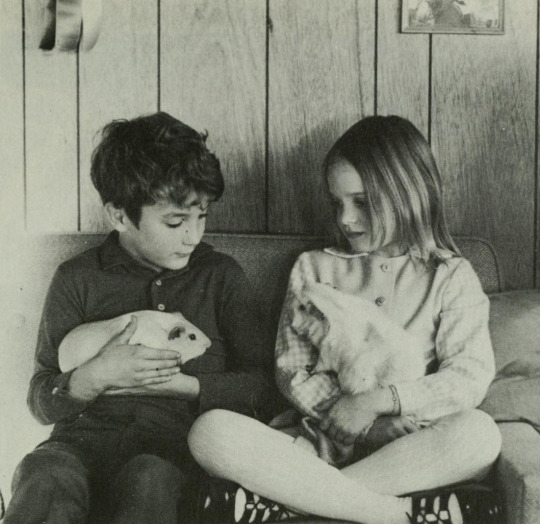
Children playing with guinea pigs
By: Mervin F. Roberts
From: Guinea Pigs for Beginners
1972
#guinea pig#hystricomorph#rodent#mammal#1972#1970s#Mervin F. Roberts#Guinea Pigs for Beginners (1972)
189 notes
·
View notes
Text

Guinea pigs
By: W. E. Castle
From: The Journal of Heredity
1910
300 notes
·
View notes
Text

Guinea pig
By: W. S. Berridge
From: The Book of the Animal Kingdom
1910
#guinea pig#hystricomorph#rodent#mammal#1910#1910s#W. S. Berridge#The Book of the Animal Kingdom (1910)
504 notes
·
View notes
Text
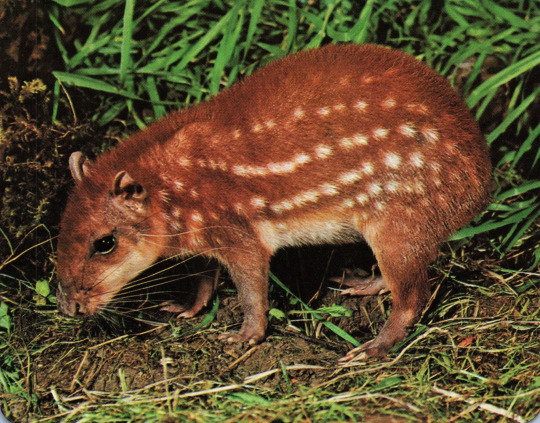
Paca
By: Albert Visage
From: Éditions Rencontre Cards
1975
275 notes
·
View notes
Text
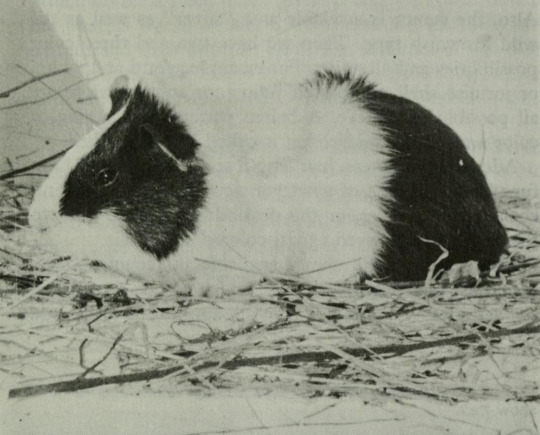
Guinea pig
By: Mervin F. Roberts
From: Guinea Pigs for Beginners
1972
#guinea pig#hystricomorph#rodent#mammal#1972#1970s#Mervin F. Roberts#Guinea Pigs for Beginners (1972)
84 notes
·
View notes
Text

Guinea pig
By: Charles R. Stockard
From: The Journal of Heredity
1910
226 notes
·
View notes
Text

Abyssinian guinea pig baby
By: Mervin F. Roberts
From: Guinea Pigs for Beginners
1972
#guinea pig#hystricomorph#rodent#mammal#1972#1970s#Mervin F. Roberts#Guinea Pigs for Beginners (1972)
143 notes
·
View notes
Text

Guinea pig with babies
By: J. L. S. Dubois
From: Éditions Rencontre Cards
1976
170 notes
·
View notes